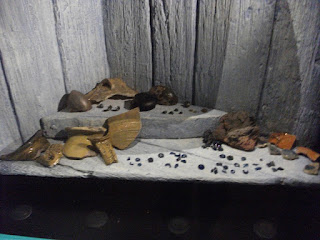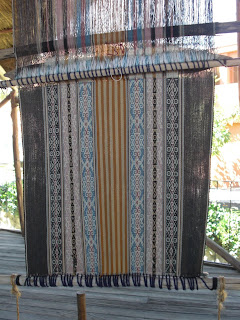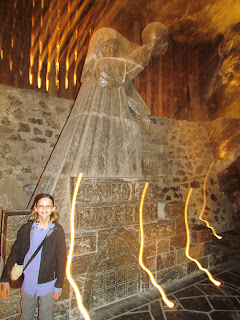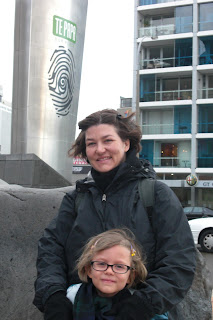I Dig a Hole
When
you walk in to the Centre, you immediately find yourself on a thick glass floor
that looks down at an archaeological site that shows the foundations of two
Viking houses. Around the room were videos about Viking conquests, and artifacts
that had been found on the site below.
From
there, we went on the Disney-like ride, a slow moving car that drove around a
model Viking town with life sized figures that spoke in another language (I
presume it was some form of Nordic) as our audio headset helpfully translated,
as well as giving insightful information on everyday Viking life.
After
this, we went through the rest of the exhibits, which featured several
skeletons, one of which had a hologram-like device that not only outlined
various health concerns, but then reconstructed a Viking woman from the bones.
It was quite impressive.
 For
some reason, my parents refused to let me buy the throwing axe in the gift
shop, so we wandered around the town, trying to find the church our dig was
taking place at. It was a surprisingly hard task, since it transpires York has
about 50 churches. Finally, however, we located the Parish Church of All Saints
(North Street), and after getting crepes, we went back to the hotel.
For
some reason, my parents refused to let me buy the throwing axe in the gift
shop, so we wandered around the town, trying to find the church our dig was
taking place at. It was a surprisingly hard task, since it transpires York has
about 50 churches. Finally, however, we located the Parish Church of All Saints
(North Street), and after getting crepes, we went back to the hotel.
We
got to All Saints at the appointed time on the first day of our dig with the
other trainees, and after a safety introduction, we went out to the site. We
were introduced to Plantie, the site mascot, and were given an overview of This
End and That End (fixed halves of the site, no matter where you are). Since the
site had been vacant since April, we were all tasked with removing the weeds
from the site.
Next,
we were all assigned a zone. My parents and I were given a space to dig in and
clean up, and I shortly found a bit of Roman samianware, as well as some green
glazed pottery. Our bit of ground turned out to be a levelling deposit, and it
was full of brick, tile, bits of pottery, animal bone, cinders, and clay. We
dug for a while, sieving out buckets full of dirt to make sure we weren’t
tossing anything of import.
 The
second day we took a picture of our piece of the site (hereafter our portion of the site will be referred to as Box) and assigned it context number 1358. Box is a
context, or a thing in the site. If we found a grave in Box, then the coffin
backfill would be a context, and the person within the remnants of the coffin
would be a context. The photograph had to be taken exactly so, with the scale
and board perfectly straight and in the exact middle of the picture. It took us
several tries. We dug and sieved some more before our second session, which was
a lesson about pottery from all ages. It was all rather a whirl of green glaze
and gritty ware, but after a while I was able to bandy some terms around like I
knew the first thing about pottery. In the afternoon, we were washing finds. We
and some other trainees stood and sat in the shade of some trees chatting as we
scrubbed dirt covered pieces of brick, tile, and pottery.
The
second day we took a picture of our piece of the site (hereafter our portion of the site will be referred to as Box) and assigned it context number 1358. Box is a
context, or a thing in the site. If we found a grave in Box, then the coffin
backfill would be a context, and the person within the remnants of the coffin
would be a context. The photograph had to be taken exactly so, with the scale
and board perfectly straight and in the exact middle of the picture. It took us
several tries. We dug and sieved some more before our second session, which was
a lesson about pottery from all ages. It was all rather a whirl of green glaze
and gritty ware, but after a while I was able to bandy some terms around like I
knew the first thing about pottery. In the afternoon, we were washing finds. We
and some other trainees stood and sat in the shade of some trees chatting as we
scrubbed dirt covered pieces of brick, tile, and pottery.
On
Wednesday, class began at the York Archaeological Trust in the conservation
lab. After an introduction about conservation, we were able to see several iron
spear tips, and were told that heavily corroded items were cleaned with a tiny
sandblaster. We were also able to look at a large sword, which was being examined.
Next, we were taken to a back room where preserved wood is looked at. We
learned that drying waterlogged wood takes months of soaking in a solution, and
that most wood has to be thrown away due to expense of preservation.
 We
returned to the church and mapped out Box using a large metal grid. We did this
so that Box could be accurately measured and located on the site. Afterwards,
we took the elevation levels using something like a tripod and a long pole. We
went to lunch at a place called Circles, which had excellent cinnamon toast,
and which my parents declared would be a daily stop.
We
returned to the church and mapped out Box using a large metal grid. We did this
so that Box could be accurately measured and located on the site. Afterwards,
we took the elevation levels using something like a tripod and a long pole. We
went to lunch at a place called Circles, which had excellent cinnamon toast,
and which my parents declared would be a daily stop.
After
the day’s dig, we went to York Minster for evensong. We got seats in the quire
again. This time, the choir consisted of girls, with men singing the lower
parts. It was quite lovely.
On
Thursday, we began to discover strange things in Box. First, we found bits of
metal in four points, and then we started finding weird holes. Our instructors
were certain we’d uncovered a grave. At that point, it was time for us to wash
finds, so we carefully scraped our area clean so we could photograph it
tomorrow.
After
the dig, we were led on an archaeological tour of York. We followed some of the
old Roman fortresses and walls, and were told about various places where digs
took place. In one building, a dig resulted in the finding of hundreds of
rabbit feet. It was quite a whirlwind of information.
 On
Friday, we documented the coffin, got a photograph, took elevation levels, and
got our drawing finished. That done, we began to excavate our occupant. We felt
certain we were almost there, but then were called to our session about
stratigraphy. One of our instructors drew level after level of deposits,
beginning with the Neolithic era, where we deposited the remains of Henry, whose
plow had broken, leading him to get food poisoning and perish of starvation.
From there, we continued with layer after layer, laying Mr. Nails to rest in
the Bronze Age after he had been hit with flying nails in an industrial
accident. We deposited the statue of Giles in a remembrance garden, and told
the tale of Giles Olaf Thorson, the shoemaker, and his son, Gilesson
Thorsonson, the exotic cheesemaker. That tale told, we went backwards and
catalogued the structures we had drawn. It was quite an adventure.
On
Friday, we documented the coffin, got a photograph, took elevation levels, and
got our drawing finished. That done, we began to excavate our occupant. We felt
certain we were almost there, but then were called to our session about
stratigraphy. One of our instructors drew level after level of deposits,
beginning with the Neolithic era, where we deposited the remains of Henry, whose
plow had broken, leading him to get food poisoning and perish of starvation.
From there, we continued with layer after layer, laying Mr. Nails to rest in
the Bronze Age after he had been hit with flying nails in an industrial
accident. We deposited the statue of Giles in a remembrance garden, and told
the tale of Giles Olaf Thorson, the shoemaker, and his son, Gilesson
Thorsonson, the exotic cheesemaker. That tale told, we went backwards and
catalogued the structures we had drawn. It was quite an adventure.
After
lunch, we returned to Box and continued uncovering the mystery inhabitant
within. My parents uncovered the skull first, while I worked to locate the
legs. I spent about ten minutes painstakingly uncovering a bone before it was
discovered that it was not human. After this, my dad found an eggshell, and I
found a decorated metal bit of coffin, but no legs. I was beginning to wonder
if maybe I shouldn’t have been joking about Mr. Nails and the industrial
accident, when I managed to uncover the legs.
Our
last activity of the week was small finds, where we got to look at some of the
objects discovered. This detailed the importance of washing, since most of the
items were thoroughly dirt caked before being cleaned up.
Next week we will document our friend
before covering him or her back up to rest in peace. The first week of the dig
was highly eventful, and I can’t wait for next week!



Comments